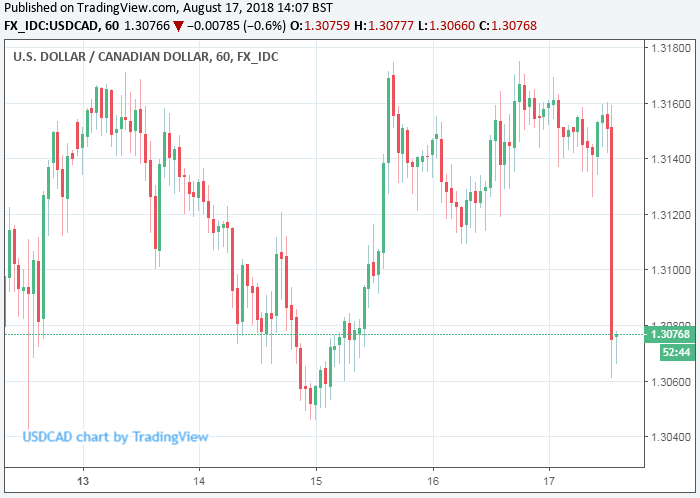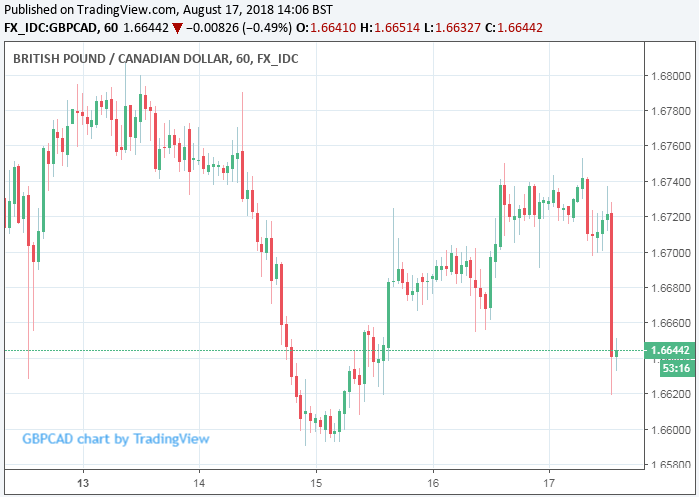Canadian Dollar Surges after Blowout July Inflation Figures Put Bank of Canada in the Spotlight
- Written by: James Skinner
-CAD rises sharply after shock increase in July inflation.
-But CIBC analysts say data shouldn't alter BoC outlook.
-And others are short CAD given worsening NAFTA outlook.

© Pavel Ignatov, Adobe Stock
The Canadian Dollar surged Friday as traders responded to official data showing a surprise and strong increase in inflation during July, which has put the Bank of Canada under a proverbial spotlight.
Canada's consumer price index rose by 0.5% during July, up from 0.1% in June and far ahead of the consensus for another 0.1% gain, which pushed the annual rate of inflation up from 2.5% to 3%.
Core inflation, which ignore volatile food and energy items so are seen as a more accurate representation of domestically generated inflation pressure, rose by 0.2% on the month. The Bank of Canada core inflation measure rose from 1.3% to 1.6% when markets had been looking for another 1.3% reading.
"Somewhat surprisingly, even with the upside surprise to the headline, the BoC's core measures continued to average exactly 2%. As such, while today's figures will likely support the C$ and result in increased speculation that the Bank could hike again as early as September, we continue to lean toward October for the next move," says Andrew Grantham, an economist at Toronto-headquartered CIBC Capital Markets.
Markets care about the inflation data because it has significant influence over Bank of Canada interest rate decisions, which are the raison d'être for most moves in exchange rates.
Changes in rates, or hints of them, are only made in response to movements in inflation but impact currencies because of the push and pull influence they have on international capital and their allure for speculators.
All of Canada's inflation numbers including the core measures have been at, above or close to the 2% target of the Bank of Canada in recent months, leading markets to reassess the once-benign outlook for Canadian interest rates.
However, Andrew Kelvin, a strategist at Toronto-headquartered TD Securities, says Canadian inflation has likely reached its peak for 2018 and that consumer price pressures should moderate from here.
"Though there may not be an urgency for the BoC to hike three weeks from now, speculation has been building over whether the upcoming slew of data will make this a non-trivial possibility," Kelvin writes, in a briefing for clients Friday. "We note however, that with nearly 80% priced for an October hike and the CAD a well populated long, CAD may be slightly more deferent to a disappointment in the data than a positive surprise."

Above: USD/CAD rate shown at hourly intervals.
The USD/CAD rate was quoted 0.66% lower at 1.3072 following the release after extending an earlier 0.08% loss while the Pound-to-Canadian-Dollar rate was 0.56% lower at 1.6636 after extending a 0.01% decline.
The WTI crude futures price was up 0.79% at $65.92 Friday while the Brent crude futures price was up 1.33% at $72.04, which might explain some of the Loonie's earlier move because oil is Canada's largest export.

Above: Pound-to-Canadian-Dollar rate shown at hourly intervals.
"Sharply higher energy prices saw Canadian inflation unexpectedly spike in July. But so far, the impact of tariffs has been fairly modest and this is a key reason why we expect further rate hikes from the Bank of Canada," says James Smith, a developed markets economist at ING Group. "We still think the direction of Canadian interest rates is up, but the risk of further rounds of tariffs, or an undesirable Nafta outcome, could easily alter that."
Sentiment toward the Canadian currency has improved in recent weeks, particularly after official data showed economic growth surging in May and exports rising at a rapid clip during June, placing the economy on track to deliver a solid performance for the second-quarter.
In addition, Canada's economy created 54,100 new jobs during July, up from a 31,800 gain in June, which was a country mile ahead of the consensus for jobs growth of just 17,000.
That pushed the unemployment back to a post-crisis low of 5.8% in July, leading analysts to conclude the Bank of Canada's September meeting is now "live" for a potential rate hike.
This is significant for currency markets because it is seen making a third 2018 interest rate rise from the Bank of Canada more likely, when just a few short weeks ago, analysts and economists were sceptical about whether the BoC would manage another hike this side of the New Year.
"For USDCAD, the 1.30/1.32 range has been notable, so we would expect the pair to find durable support towards the lower end of the range on an upside CPI surprise. CAD crosses have also neared conditions consistent with 'overbought' territory. All of this suggests that a positioning realignment is an appreciable risk," Kelvin concludes.
NAFTA Negotiations Stall and Outlook Worsens
The TD Securities team are betting on a continued rise in the USD/CAD rate up toward the 1.35 threshold as they say Bank of Canada monetary policy will not be enough to support the Loonie while the North American Free Trade Agreement hangs in the balance and the global market environment remains un-supportive for "risk assets".
Negotiators from all sides of North American borders have been attempting without success to renegotiate NAFTA, which facilitates tariff-free trade between its signatories, for more than a year now ever since President Trump threatened to withdraw from it unless terms more palatable to the US administration can be agreed.
Canadian foreign minister Chrystia Freeland was excluded from the latest round of NAFTA talks as US officials sought to make headway in the negotiations with just their newly-minted Mexican counterparts.
"I'm in no rush. We want to make the right deal. NAFTA has been a disaster for our country," says President Donald Trump, in a cabinet briefing Thursday. "As far as Mexico and Canada — Mexico, Bob told you about — we’re not negotiating with Canada right now. Their tariffs are too high. Their barriers are too strong. So we’re not even talking to them right now. But we’ll see how that works out. It will only work out to our favor."
TD Securities analysts previously estimated a US withdrawal from NAFTA could see the Canadian Dollar fall by 20% as markets would be forced to mark down their expectations for Canadian economic growth and interest rates over the longer term. The USD/CAD rate is already 4% higher thus far in 2018.
Advertisement
Get up to 5% more foreign exchange by using a specialist provider to get closer to the real market rate and avoid the gaping spreads charged by your bank when providing currency. Learn more here




